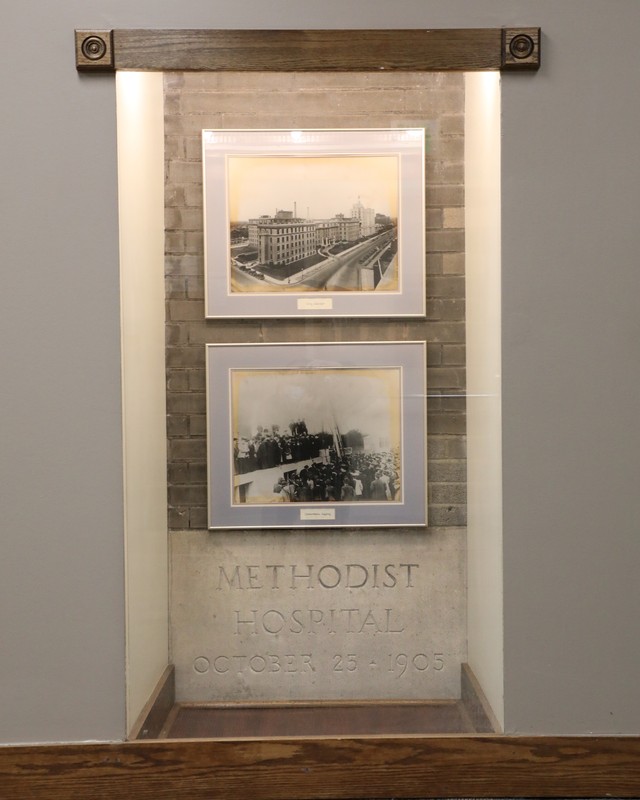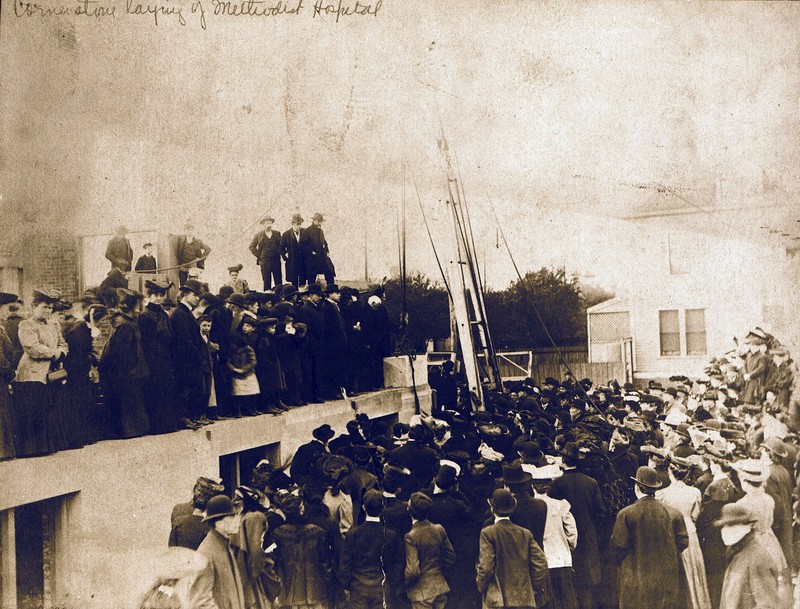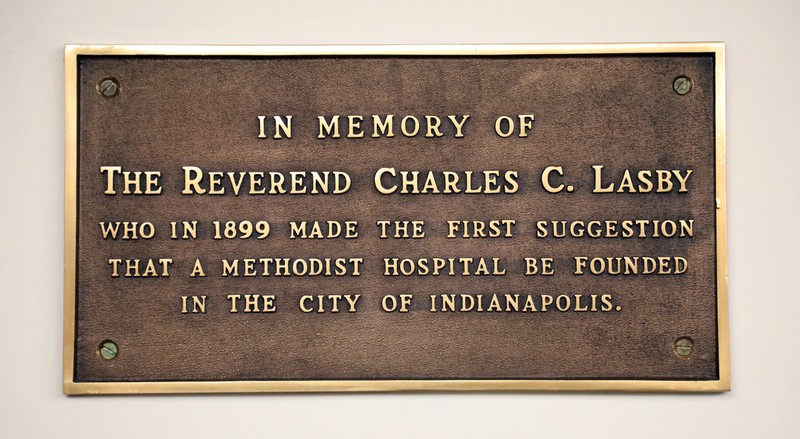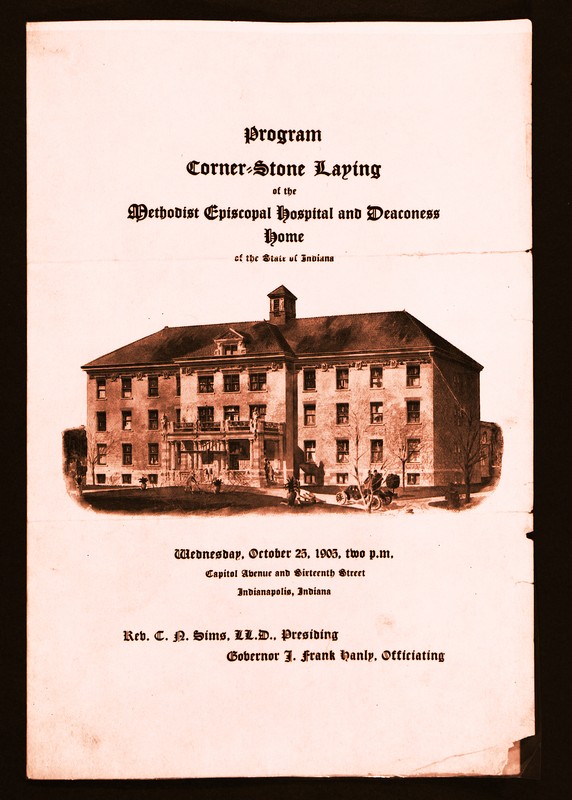Cornerstone
Introduction
Text-to-speech Audio
In July of 1899, the city of Indianapolis prepared to host the fourth annual Epworth League Convention. The convention proved to be a great success with thousands of young people attending from across the country. The convention ended with a surplus of $4,750, and a debate on how to use the money ensued. After the suggestion from Reverend Lasby, pastor of Central Avenue Methodist Church, the committee voted to use it as seed money for a new Methodist Hospital. On April 1, 1901, the board appointed Revered Dr. W.R. Halstead as a full-time fundraiser with a salary of $2,500 a year. In 1905, with half of the funds in hand, the Board of Trustees decided to proceed with construction. The cornerstone of the hospital was laid in the same year.
Images
Methodist Hospital Cornerstone

Laying the Cornerstone

Lasby Plaque

Cornerstone laying program

Backstory and Context
Text-to-speech Audio
In July of 1899, the city of Indianapolis prepared to host the fourth annual Epworth League Convention, the official young people’s organization of the Methodist Episcopal Church. Roberts Park, an influential Indianapolis Methodist Church, was chosen as the headquarters for the convention. The Epworth League Convention proved to be a great success with thousands of young people attending from across the country and money left over. The convention ended with a surplus of $4,750, and a debate of how to use the money ensued. Reverend Lasby, who was integral in founding the first Methodist Hospital in the United States in Brooklyn, New York, suggested that the money be used to establish an Indianapolis Methodist Hospital. After little debate, the Epworth Committee supported the idea and chartered a Methodist Hospital Board of Trustees to oversee the project. When the idea was brought to the Indiana Conference of the Methodist Episcopal Church, state leaders argued against establishing a hospital because it would create an additional ongoing cost for the conference to absorb. A young preacher, Reverend George M. Smith, who had never addressed the crowd before immediately rose to his feet and gave a heartfelt counter argument. His counterargument turned the opinion in favor of the project. George Smith later became the superintendent of Methodist Hospital from 1923-1931.
On December 4, 1899, the Board approved a site for the hospital on the northwest corner of Illinois Street and 29th Street. The announcement of this site brought intense criticism from Indianapolis doctors who claimed the new hospital would be too far from the people to adequately serve their medical needs. After defending their location for some time, the Trustees finally decided to find a location nearer to downtown. While looking for a new location, the Board was also focused on fundraising. The Board quickly realized the difficulty of raising the estimated $200,000 necessary for a hospital, and they determined a full-time paid fundraiser was needed. On April 1, 1901, the board appointed Reverend Dr. W.R. Halstead with a salary of $2,500 a year. He created a fundraising incentive system: if a donor donated $14,000, they could name an adult ward; $7,000, a children’s ward; $2,500 a two-bed room; and $1,500, a one-bed room. Among these large donations, there were thousands of smaller donations, many as small as 15 cents.
While Reverend Halstead was focused on fundraising, the Board found a new hospital location and appointed a building committee. The new site was a former baseball park at the corner of 16th Street (then Tinker Street) and Capitol Avenue. The price of the land was $14,000, about double the price of the first proposed location. The Board worked out a deal for $3,000 as a down payment followed by a series of payments extending over four years with a semi-annual interest rate of four- and one-half percent. With the new location confirmed, the Board established a building committee and selected the Indianapolis architectural firm of Vonnegut and Bohn to draw the plans. After a visit to some public and private hospitals in the Midwest region, the Board decided to proceed with the pavilion plan, one of the three plans proposed by the architects. The plan called for multiple separate but connected buildings that could be built over time to accommodate future expansion. The pavilions provided the best possible arrangement of wards, rooms, and accessory buildings in accordance with the best medical theory of the time.
In March 1905, with half of the money in hand, the Board of Trustees decided to proceed with construction. The Board hoped that beginning construction would encourage more people to donate. Additionally, the Board could borrow money to finance the building if necessary. The dream of a hospital started to become reality. On October 25, 1905, influential Indianapolis citizens and the public gathered around for the laying of the cornerstone. Two of the speakers at the event were current Vice President of the United States, Charles Warren Fairbanks, and U.S. Senator from Indiana, Albert J. Beveridge.
Although originally planned to take less time, the hospital took three years to complete. On April 26, 1908, the Methodist Hospital and Deaconess Home opened to the public.
Sources
Reed, Kenneth E. and Leary, Edward A. A History of Methodist Hospital of Indiana Inc.: A Mission of Compassionate Heath Care. Indianapolis, IN, 2007 https://indianamemory.contentdm.oclc.org/digital/collection/HIUH/id/556
Newspapers Consulted:
Indianapolis Star
Indianapolis News
Materials in IU Health Archives Consulted:
Board and Committee Minutes
The Beacon Newsletter
IU Health Archives
IU Health Archives
IU Health Archives
IU Health Archives
